How to plant lemon at home?

Lemon is a healthy, but at the same time capricious fruit. It is very difficult to grow it at home. The store tree reluctantly acclimatizes, and when grown independently, the lemon gives only greens. Let's talk about the methods and possibilities of grafting an exotic plant at home.
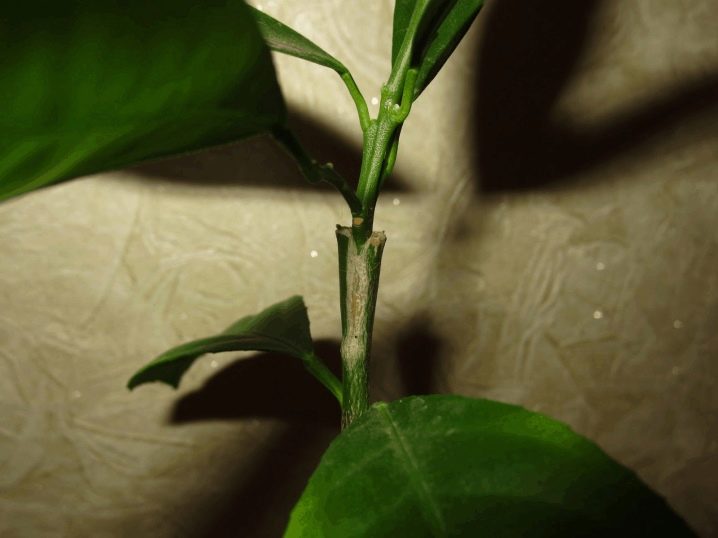
Dates of the procedure
It is best to vaccinate the plant during sap flow or from mid-April to late May. This applies to cuttings.
For copulation, the timing is different: with the onset of spring and before the start of the sap flow process.
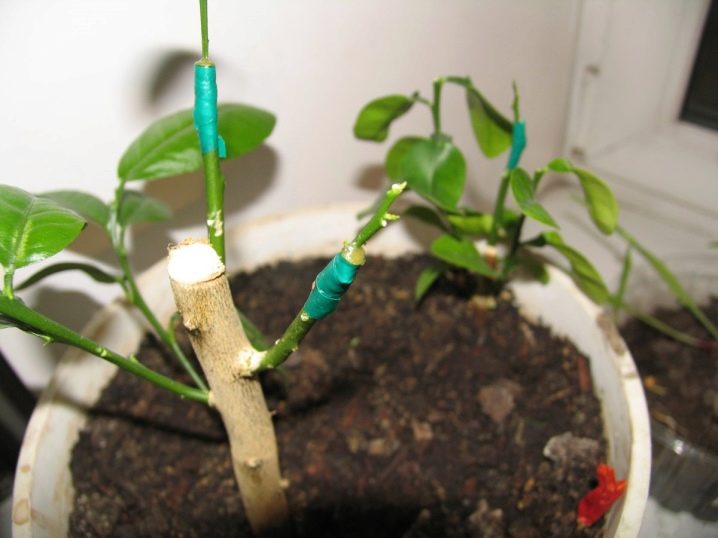
Preparation
Preparation is as important as the procedure itself. Before starting work, you need to prepare all the tools:
- any damp rags;
- garden pitch;
- polyethylene or a bag;
- a piece of thick fabric or tape;
- any sharpened tool.
It is recommended to treat tools with an alcohol-based substance, hands too. This work is best done away from vegetation, dogs, birds, and cats.


Vaccination methods
Before talking about methods, it is useful to understand the terminology.
A graft is a tree that already bears fruits of a certain variety. For such purposes, take a fruiting tree that grows well in apartment conditions.
Under the rootstock is meant a tree that has grown from a lemon seed in a room environment. Moreover, this plant is not fruitful.
It is possible to plant a lemon at home using three methods. This is copulation, budding and splitting.
There are significant differences between them: different location of the scion on the rootstock, different places of cuts.


It is necessary to decide on the stock. In order for the exotic to bear fruit in the future, it is better to take an annual plant with a diameter of less than 5 millimeters, grown from a stone. It is recommended to use the bush up to the age of 2.5 years. In the future, all vegetation processes slow down, and on the trunk with hardened bark, foreign materials do not take root or take root with difficulty. In order to have fruits in the future, it is recommended to pay attention to the varieties intended for growing at home: Meyer's lemon, Dioscuria, Ravlovsky, Kursk, Maykop.
You need to observe the tree for at least two months. If there is at least some suspicion of a disease, the presence of pests or a weak root system, then vaccination is not worth it. You also need to pay attention to the kidneys: they must be healthy and intact.
Numbing is considered one of the most commonly used and simplest methods.
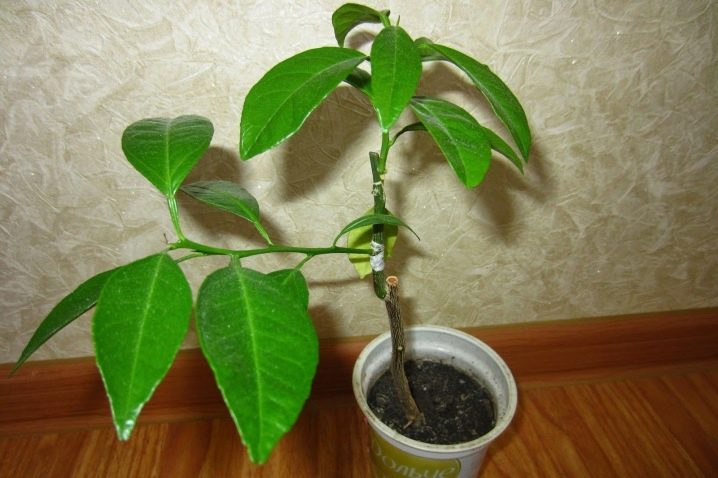
Experts choose a part of the shoot with an eye or bud. The graft is fixed in an incision on the stem. It is carried out in August on a sleeping bud or during sap flow in late spring.
For grafting, a stalk is taken into the split, fixed in an incision on the stem of the stock. The event takes place with the onset of spring.
When copulating, a stalk is taken from a fruiting tree in winter or early spring, at a time when the buds have not yet blossomed. The branch of the tree is connected to the handle, thoroughly tied. Pick up a branch and a stalk of the same diameter.
We offer the correct instruction on the methods of vaccination step by step.
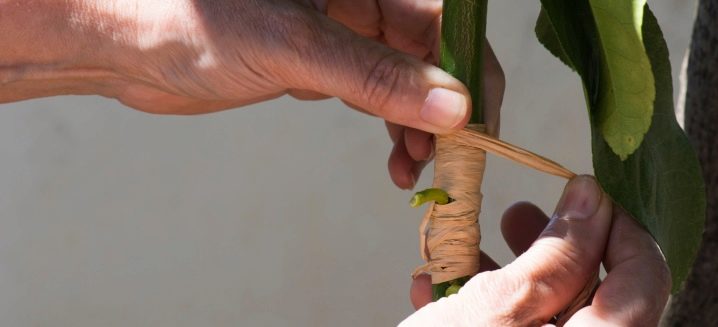
Budding
For budding, it is better to choose a bush whose trunk is 6 millimeters in diameter. All the work is done like this.
- In the lateral part of the trunk, a T-shaped incision is made: horizontally up to 1 centimeter, vertically - up to 2.2 centimeters.Experts advise cutting with special care, trying not to touch the deep layers of the trunk.
- The casing is slowly pushed back.
- A bush with a bud is cut from a fruitful plant. Connect with an incision so that it lies under the bark to the end.
- The area of the incision is twisted with a piece of cloth or tape without touching the kidney.
- After it takes root, you need to cut the rootstock five millimeters above the incision, it is constantly recommended to cut off new branches on the stems that are not needed in the future.
In this case, two kidneys can also be grafted.
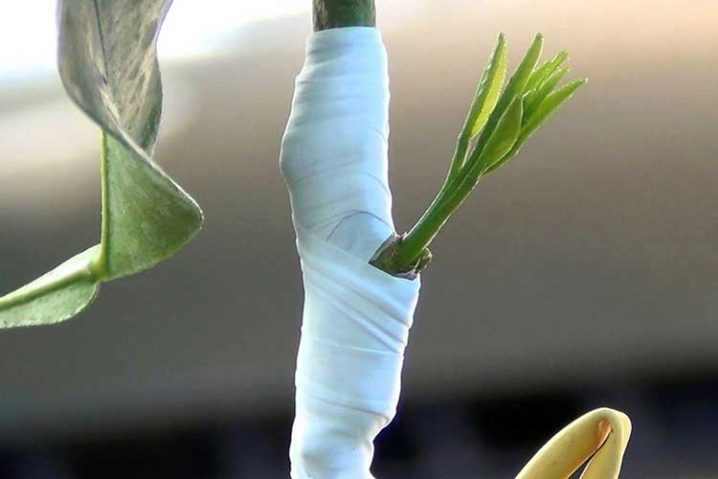
Into the cleft
For this method, it is recommended to take a stem with a bud from a plant that is already bearing fruit. The place of the scion and cut is treated with a slightly moistened rag. Then they act according to the following scheme:
- at a height of 5-6 centimeters from the ground, a stalk is cut off from a non-fertile tree;
- make a vertical cut, making a split up to 3 centimeters deep;
- shallow cuts up to 3 centimeters are formed on the scion;
- gently insert the scion into the cleft;
- everything is twisted with a tape, the place of trimming at the wild is smeared with pitch.
The procedure can be carried out in a semi-cleavage or in a complete cleavage. When carrying out semi-splitting, one side of the rootstock is affected.
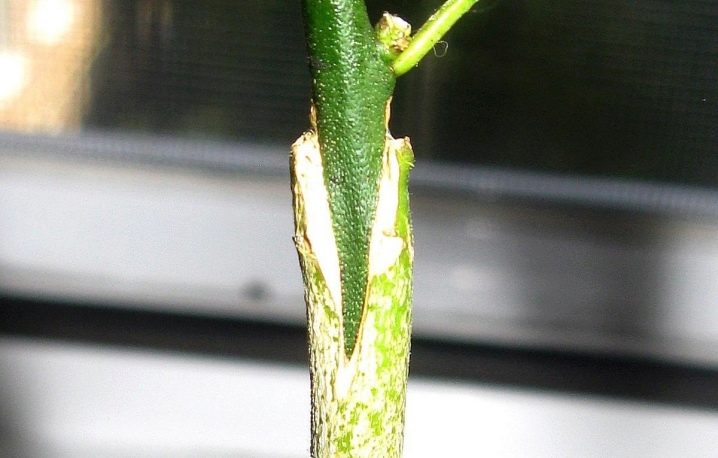
Copulation
This method involves preparing the stock and scion of the same diameter as in budding. Then you need to act like this.
- An incision is made on the rootstock and scion, the bark is peeled off up to 4 centimeters long.
- Prepare cross sections up to one centimeter deep.
- The workpieces are tightly inserted into each other. On the rootstock, it is necessary to deepen the cut, and the branch is fixed on the scion with a notch.
- All points of contact are rewound with tape or any other elastic material.
So you can plant a couple of branches at the same time. After vaccination, the plant must be carefully looked after and monitored.
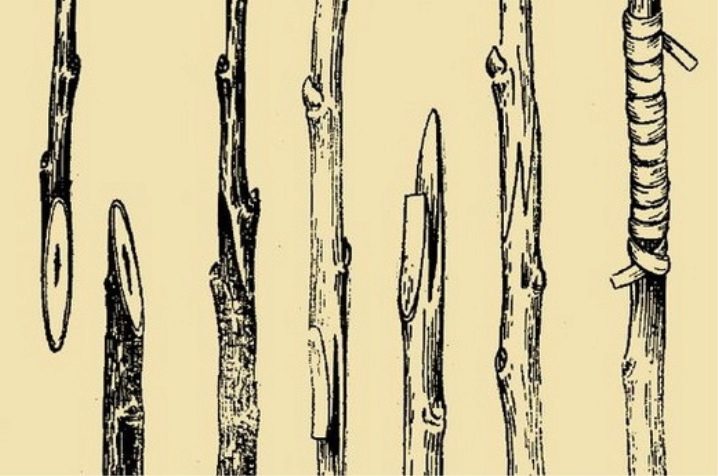
Follow-up care
After such a procedure, it is necessary to create almost sterile conditions for the exotic. It is immediately recommended to equip a mini-greenhouse:
- the grafted bush together with the container is sent under polyethylene or in a large bag;
- it is recommended to put a small container in the greenhouse to maintain optimal humidity;
- for airing in the morning and in the evening, the bag must be slightly opened for a few minutes, gradually increasing the time.
After two weeks, it will become clear whether the vaccination was successful or not.
If the petioles and leaves are easily separated, then everything is fine, and if the trunk has changed its color to a dark color, then all the work was in vain.
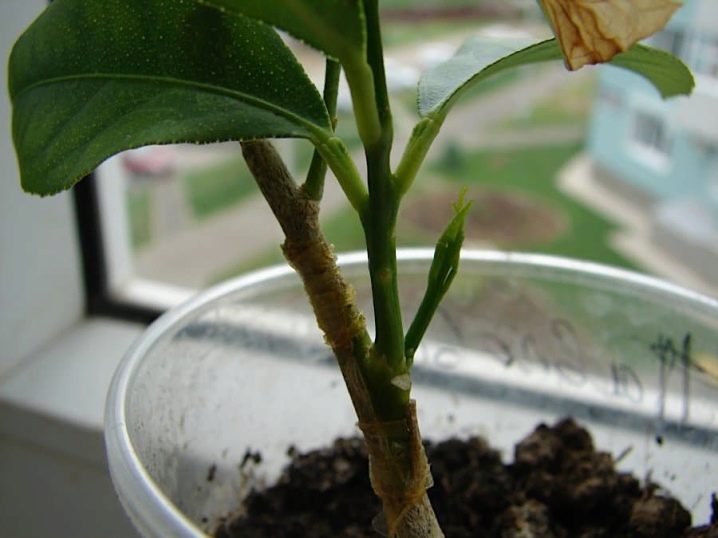
There are several reasons for failure: the plant was not prepared, an infection got in, the procedure was incorrect. To be successful, it is recommended to prepare several plants for grafting at once. Do not forget about processing tools, you can use a special sharp pruner. Among the advantages of such a pruner, it is worth noting that even and identical cuts are obtained, there are great chances of avoiding infection, faster and better fusion of the grafting material. Interestingly, the instrument has several types of nozzles for carrying out vaccinations with different methods.
If everything went well, the bandage can be removed after two weeks. Then you need to fix the young branch in an upright position. The plant needs regular watering and maintaining moisture, a certain temperature regime. After the vaccination, the fruiting period of the cultivated tree varies from 2 to 4 years. There are varieties with flowering the next year after vaccination.
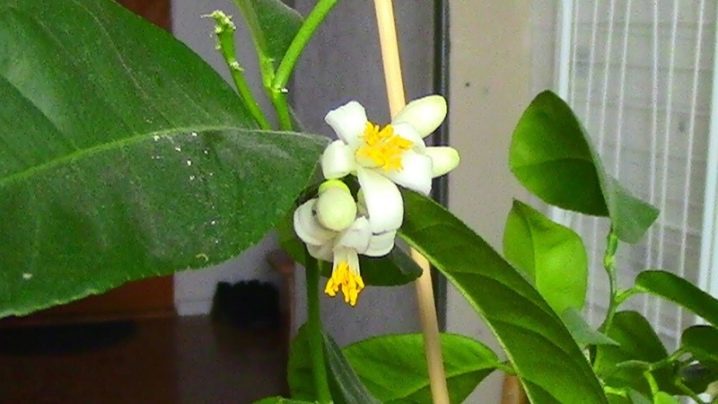
Let's say everything went well, and the lemon never bloomed - this does not mean that a mistake was made somewhere. Budding always begins in spring at temperatures from +15 degrees.
Blooming exotics are cross-pollinated. To put it simply, they transfer pollen from one flower to the next with a brush.

There are also environmental factors, based on which the plant refuses to bloom.
- Not enough light.Continuous and bright lighting is recommended, but not direct, scalding sunlight. If the light is too bright, the grafted exotic gets a burn or leaves fall.
- Low room temperature. Do not keep the lemon tree near the air conditioner, in places with drafts or low temperatures. The optimal temperature regime is + 20-25 degrees.
- Pruning injured the plant.
- The soil is of low acidity.
- Wrong mode of maintaining humidity. It is necessary to irrigate the lemon every day from a spray bottle with warm water (+ 30-32 degrees), the room should be humid.
- Improper watering. It is necessary to water regularly, observing the moisture content of the soil, preventing the soil mixture from drying out to a depth of 1 centimeter.
- Little fertilization was applied to the plant. Every 2 weeks after the procedure, fertilizing is carried out using fertilizers marked "for citrus fruits".

3 weeks after the vaccination, it is recommended to mulch the soil with humus. With the rapid growth of shoots and the absence of flowering, we advise phosphorus, and do not feed with nitrogen or remove it.
After carrying out the necessary agricultural technology, you can wait for spring flowering. Further, from May to November, the lemons will ripen. By the beginning of December, you can eat them.
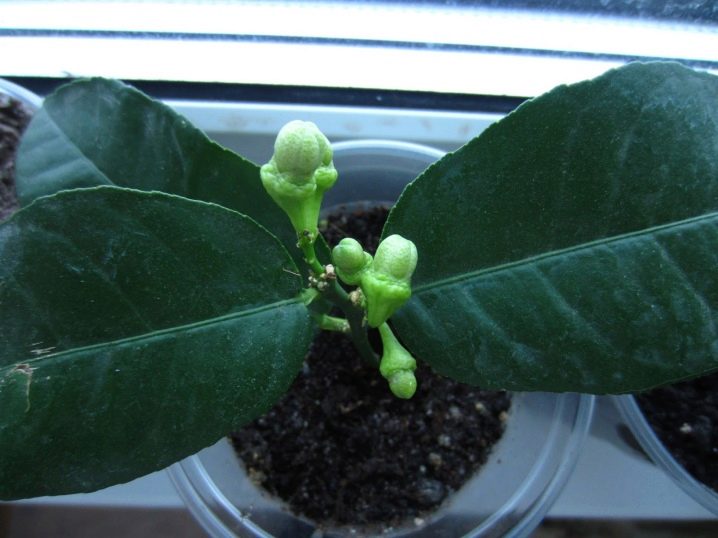
Of course, the technique is not easy, but if all the recommendations and rules are followed, vaccination gives many advantages:
- becoming an experienced citrus grower, you can decide to graft not only on lemon, but also on another citrus tree, for example, tangerine, grapefruit, orange;
- helps to speed up the harvest time of the domesticated fruit tree;
- at home, you can collect high-quality, environmentally friendly fruits.
You can plant a lemon on your own, but it is very difficult. Not always everything works out the first time, so experts advise taking several wilds at once.
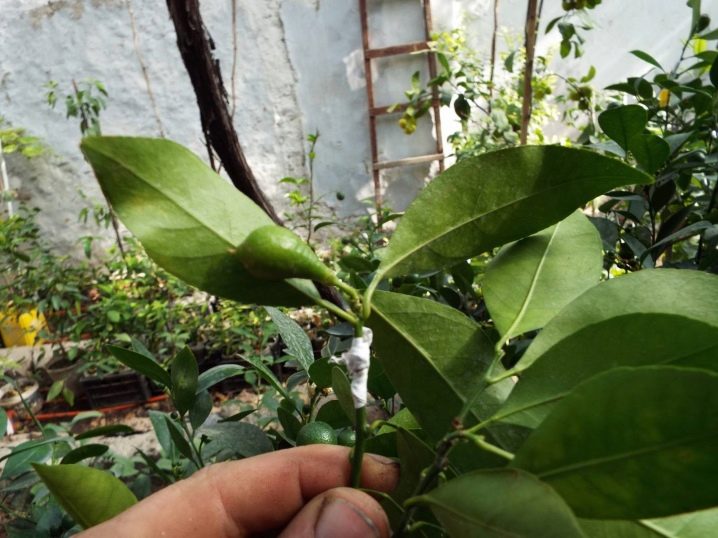


























The comment was sent successfully.